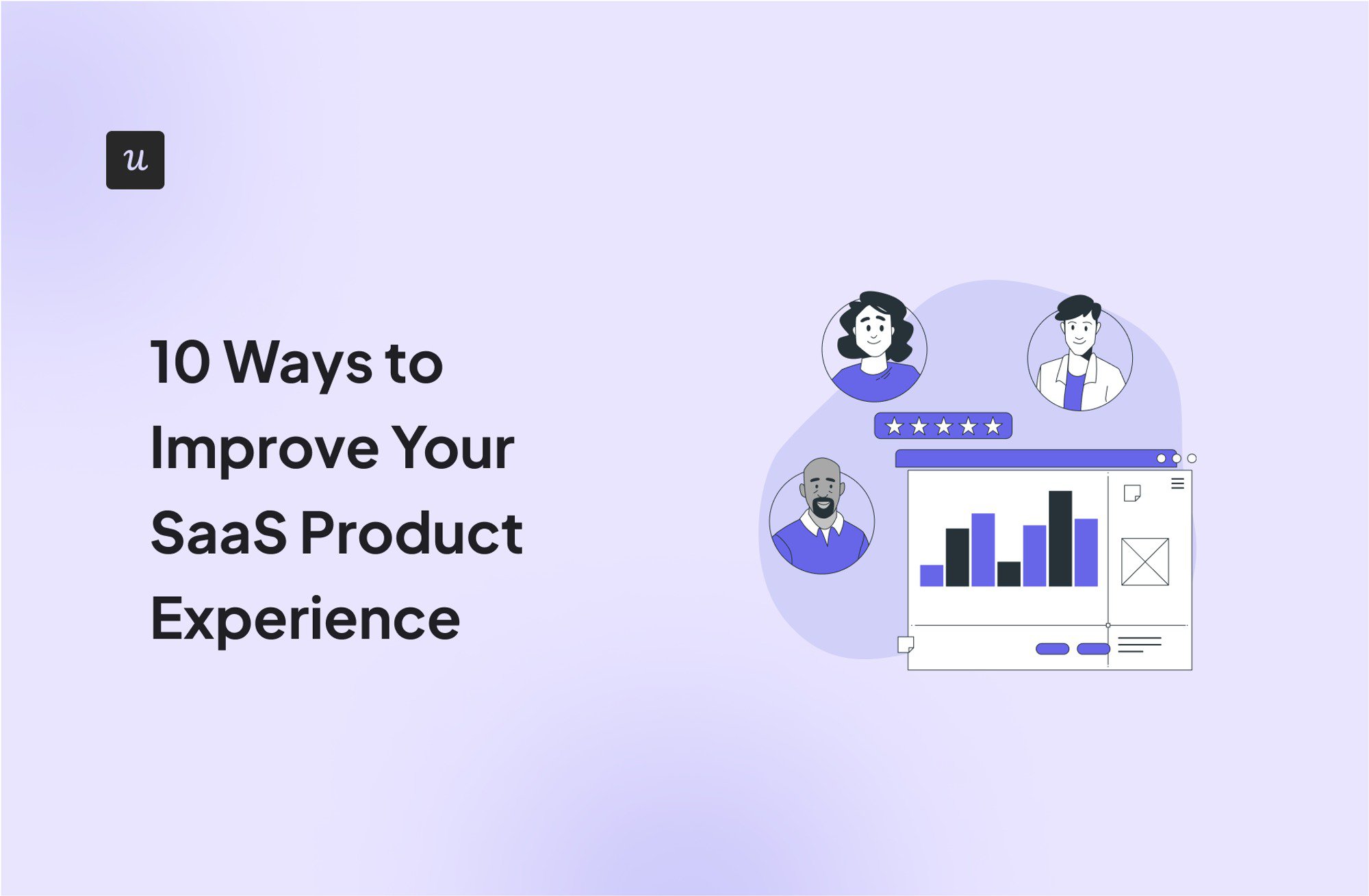
While your SaaS company’s success depends on several elements, the most crucial ingredient will always be your product experience.
Providing a great SaaS product experience helps companies reduce churn and improve product management metrics like customer satisfaction and customer lifetime value.
But what is SaaS product experience, and why should you focus on it? Let’s dive in to find out, exploring the what, why, and how of perfecting it in your company.
What’s your biggest challenge with your current SaaS product experience?
How do you currently gather user feedback to improve your SaaS product experience?
How personalized is your user onboarding right now?
Ready to build a SaaS product experience that drives growth?
Based on your answers, it’s clear you’re focused on creating a better product journey. Userpilot can help you deliver personalized in-app experiences, gather actionable feedback, and increase user activation—no code required.
Try Userpilot Now
See Why 1,000+ Teams Choose Userpilot

How to improve SaaS product experience: Summary
- For a SaaS company, product experience includes all customer interactions and perceptions related to your product’s usability, design, performance, features, and emotional impact.
- A great SaaS product experience boosts customer satisfaction, adoption, and engagement, builds brand advocacy, reduces churn, and, ultimately, drives revenue growth.
- Not to be confused with customer experience, which is broader and envelops all interactions a user has with your company, not only those specific to the product.
- Several teams contribute to enhancing the product experience to drive SaaS sales. These include product management, design, development, marketing, and customer success teams.
- To improve your product experience, conduct user research and create personas to gain insights into customer behavior, preferences, and problems.
- Similarly, use feedback to tailor onboarding and in-app messages, and offer interactive self-service options and contextual help to enhance engagement and satisfaction.
- Lastly, continuously iterate by analyzing feedback, conducting A/B tests, and refining user experiences to discover what works best.
- Ready to perfect your SaaS product experience strategy? Schedule a Userpilot demo and see how you can get started.
What SaaS product experience?
Within the SaaS industry, product experience encompasses all the interactions customers have with your product.
These interactions range across multiple elements, such as User Interface (UI), User Experience (UX), customer journey mapping, feedback loops, and user research.
Here’s an example to understand these elements better.
Suppose you just signed up for a new tool. It’s easy to use and navigate, and there’s a helpful onboarding process to guide you. Whenever you run into trouble, contextual tooltips pop up, or you receive prompt help from customer support.
All this results in one thing – a positive product experience, ultimately driving SaaS sales and revenue growth!
It should be noted that product experience differs from customer experience. Product experience focuses only on customer satisfaction related to interactions with the product itself. However, customer experience is broader, including all customer interactions with your company beyond just the product.
Which teams are responsible for product experience?
A successful product experience, one optimized for driving SaaS sales, requires a combined effort from cross-functional teams. Here’s an overview of what teams are involved in this process:
- Product Management Team: Defines the product vision and features based on market research and customer feedback, ensuring alignment with user needs to enhance the SaaS experience.
- Design Team: Creates intuitive user interfaces (UI) and user experiences (UX) for seamless usability and user flows, thereby contributing to an engaging product experience.
- Development Team: Refines the product’s technical aspects to enhance its functionality, ensuring it runs smoothly and bug-free while incorporating user feedback to remove any pain points.
- Marketing Team: Communicates the product’s value through messaging, positioning, and promotional strategies, thereby aligning customer expectations with the actual SaaS experience.
The importance of SaaS product experience
Apart from boosting customer satisfaction and SaaS sales, there are many other benefits to focusing on your SaaS product experience. Here are just a few of them, specifically within SaaS companies:
1. Improved customer retention:
- Positive product experiences reduce churn rates by effectively meeting user needs.
- For example, a product with an unnecessarily complex UI is bound to see more churn as compared to one with a streamlined and simplified UI.
2. Increased product adoption:
- Similarly, good product experiences also lead to higher user sign-ups and usage.
- Customers don’t adopt products that aren’t of value to them. Therefore, by integrating requested features based on user feedback, you create more value, which is crucial for increasing adoption.
3. Enhanced user engagement:
- Engaging experiences increase how often users come back to your product and utilize features to derive value.
- For example, using customer data to personalize onboarding, demos, and other guidance results in users spending more time exploring and engaging with your product.
4. Improved brand advocacy:
- Satisfied customers are more likely to become loyal brand advocates who promote your product.
- Collecting customer feedback, acting on it, closing feedback loops, and providing proactive customer service – all these are ways you can win over more customer advocates.
5. Increased bottom line:
- Lastly, refining product experiences directly impacts revenue through higher conversions and better brand reputation.
- Let’s compare two companies. One provides a great experience, with sales professionals helping whenever needed, while the other is hard to use, with no support available. Clearly, the one with a better experience will see greater conversion, ultimately boosting the revenue.
How to improve your SaaS product experience
Next, it’s time to look at ways you can perfect your SaaS product experience. There’s a lot to cover, so we’ve consolidated it all into the top 10 strategies you can rely on.
1. Understand your users’ needs and expectations
Start by analyzing your target customers and their pain points. Some helpful ways to discover and analyze customer needs are:
- Conducting user research: Understand user behavior, identify experience gaps, and remove friction to improve the experience. Important research methods include usability testing, interviews, feedback surveys, and product analytics.
- Creating user personas: Personas unlock real insights about customers, their preferences, jobs to be done, and pain points. Try user persona surveys to collect such information and make necessary improvements.

2. Establish effective user feedback mechanisms
Regularly collect customer feedback to unearth any friction points that need improvement to drive SaaS sales. Here are some tools to consider when establishing such feedback mechanisms:
- Surveys.
- User testing.
- In-app feedback.
Use different surveys and gather both quantitative and qualitative feedback to gain a more comprehensive view of customer satisfaction. Consider surveys like:
- Customer effort score (CES).
- Customer sentiment score.
- Net Promoter Score (NPS).

A good example is Asana’s exit survey below. This highlights that just because a user leaves doesn’t mean their feedback isn’t just as valuable for future improvement.

For qualitative analysis, deep dive into user interviews and customer development, focusing on open-ended questions for maximum insights.
For example, you can interview various user segments, like engaged or power users, and use these insights to improve product experience.

3. Analyze the current state of your product experience
After feedback collection, analyze the data you’ve gathered in the process. To make analysis easier, adopt tools like Userpilot to access survey analytics and track satisfaction metrics.

Such platforms are also great for quantitative analysis like user behavior analytics, feature tagging, custom events, and more.

4. Find out what contributes to customer success
Product analytics helps you learn what features users interact with the most, how they use them, what the bottlenecks are, what creates value, etc.
By analyzing product usage patterns, you will identify happy paths that lead to customer success and, consequently, SaaS sales. You can then optimize the user experience to replicate these experiences and design a standardized process that leads to better results.
This practice works great for improving feature adoption and product stickiness.

5. Establish clear goals
Based on the results of your analysis, set up clear goals for improving your SaaS product experience.
Suppose your findings suggest that a lot of new users churn after onboarding. That might mean that your onboarding process needs an improvement.
Therefore, you could set a goal to increase customer retention by 20% through enhanced onboarding and personalized customer journeys.

6. Personalize product experience
Next, use customer feedback to personalize product experiences for greater customer retention and engagement.
For example, you could set up welcome surveys to collect information about customer use cases, industry, jobs to be done, etc. Next, use this information to tailor onboarding flows and in-app messages with custom recommendations.
This way, you can adjust the overall product experience based on specific user needs.
Here’s how Notion uses the onboarding process to learn more about its new users:

7. Provide interactive self-service guidance
Many SaaS products have a steep learning curve, which can be frustrating and stressful for their users.
So, helping your customers understand and explore your tool more easily is key for improving product experience.
For example, you can create interactive walkthroughs, guides, and progressive onboarding flows using platforms like Userpilot.

Similarly, self-service options keep your customers engaged and reduce the workload for your customer service team. This way, users can troubleshoot independently, using knowledge bases and resource centers.

8. Offer contextual help based on user behavior
Help is most effective when provided at the right time and place.
That’s why contextual help, such as in-app guidance, tooltips, and tutorials, is so beneficial.

This sort of help provides immediate and relevant assistance tailored to the user’s current problem. Such proactive support reduces user frustration and boosts the overall SaaS product experience.

9. Ensure effective and responsive customer service
Support teams play a crucial role in enhancing product experiences. That is why you must ensure that you provide personalized customer service, prioritizing first-contact resolution for greater customer satisfaction.
Also, gather feedback after every support interaction. This way, you can continuously learn and improve your happy customer service using real customer insights.

10. Conduct experiments and A/B tests
Lastly, to perfect your customer-centric approach to product experiences, experiment and discover what works best.
Use A/B testing to find what resonates the most with your users. For example, test different in-app content, like product announcements, onboarding, recommendations, etc. Whichever variant gets the most traction is the clear winner for an improved experience.

Conclusion
Perfecting your SaaS product experience might seem like hard work, but it is crucial for long-term success.
Focus on understanding user needs, personalizing product experiences, providing self-service options and proactive support, and continuously experimenting.
Follow these strategies and soon you’ll create a product that not only meets customer expectations but exceeds them.
Want to get started optimizing your SaaS product experience? Get a Userpilot Demo and see how you can boost your engagement and retention metrics.







